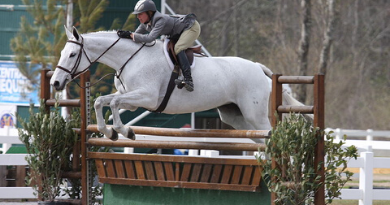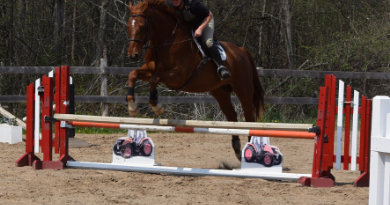What makes a winning hunter round?
What makes a winning hunter round?
It seems like a secret doesn’t it.

It is annoying when you see someone – who in your opinion – does a poorer round get a better score.
What’s up with that?
Why would a horse that pops the rails in the cups and a sloppy lead change and maybe other misdemeanors pin ahead of a solid steady round.
Sounds easy enough to win a hunter round.
But what do you have to do to win?
I know after judging at shows from the local training shows to the international ring, sometimes people REALLY don’t know what it takes to win a hunter round.
And I have heard about it.
As a judge and coach I have heard the comments. Things like:
- The judge doesn’t like <name of child>’s pony
- The judge doesn’t like <color of said pony>
- <Name of child> forgot her bows so she didn’t place
- <Name of pony> doesn’t have chrome so s/he didn’t place.
Or some other excuse.
The truth is,
Unless you have sat and watched all the horses/ponies go and figured it all out,
The judge REALLY does want you to win. There may have been five, ten or 17 other competitors that may have had a better trip.
Or
You maybe had a great trip and just squeaked out of the placings.
I’m here to tell you
THE JUDGE DOES LIKE YOUR PONY OR HORSE.
And as a judge myself I really hate hearing that the judge doesn’t like you.
They/We are just trying to do our job and “do right” by you.
How to Win at a Hunter Show
Have you been watching a show and noticed some riders continue to win and place and others seem to do all right things but never place?
Points are important and there could be a one point (or half a point) difference between first and second place.
Don’t throw points away
Judging hunters is not as easy as it looks, as a horse show judge some competitors lose points on simple things which can net you a first place ribbon or championship.
Number 1 thing a horse has to do?
The horse must get to each fence. This means:
- No refusals – Expert Advice to Avoid Refusals
- No popping chipping or hopping – Avoiding that Chip – Exercises to help erase that chip
- No rushing – Avoid the rush – Rushing your fences, can he be cured.
- Must get to the right spot – Finding the Right Spot
A summary of the scores
Most judges award points or score hunter rounds based on a score of 100. Remember the horse with the best form over fences should win the class. So:
- 90-100 Excellent – good form, gets all the spots and beautiful turnout.
- 80-89 Good to Very Good/or an excellent horse with minor mistakes
- 70-79 Average/or a good horse with minor mistakes –
- 50-59 One Major Fault: Hind Knockdown, Adding astride in an In & Out
Very bad fence
Dropping a leg
Trotting on course
Cross canter – disunited canter
Wrong Lead - 40-49 Serious Major Fault: Front Knockdown, Refusal, Extremely dangerous jumping
- 30-39 Two or more serious faults
- 10-29 Very Unsafe and dangerous; but avoids elimination
- Elimination
I invite you to send me an email and share your experiences. If you are looking for ways to up your scores? I’d be happy to discuss it with you.
You know, we all have unique experiences and sharing our stories will improve our showing abilities.
Some Judges do not award a series of points but use a ‘ladder’ system which rates one horse higher/lower than another. Either way, this will give you an idea of how some judges may judge.
The main thing the horse has to GET TO THE FENCE!
LOL
Sometimes that doesn’t happen.
It reminds me of when I judged a show and the horse was turned out beautifully.
Pro braid job, sparkling tack and spotless rider turnout as the rider entered the ring after a full in-gate hoof polish.
I was ready to be amazed.
The circle was great and the course started.
Jump 1 – check
Jump 2 – hmm not so good. Then a trot,
Jump 3 the horse just cantered by. On their way to the in/out-gate.
Moral of the story – You have to get to the jumps. (at least she looked good)
The Naughty List
The ‘naughty list’ is the list the judge keeps tally of naughty outbursts, wrong leads and dropped rails. As a judge, we try not to use horses on the naughty list when placing competitors at a horse show. Sometimes, when there are few people in the class, we often have to use horses which may be on the naughty list.
Things which can put you on the naughty list are:
- – Refusal. A refusal, run out or disobedience is an immediate score in the 45 and put on the naughty list.
- – Knock down. A knock down is also a low score. Just above a refusal. And this is interesting, most judges record if it is a knockdown from a lazy front hoof or a knockdown from a hind leg. The Best Form Over Fences Should Win The Class
A hind leg knock down is less severe and in my case, will place over a rail knocked down from a front leg. This is because a horse that hits the jump with a front leg will be in jeopardy of causing a rotational fall, flipping over or other bad accident.
Usually if a horse hits a rail with a hind leg it is from the rider getting left behind or coming back into the saddle too soon. - – Unruly behaviour. This is beyond a wrong lead but actually kicking out, rearing or being nappy at the gate.
- – Wrong lead.
- – Breaking into the trot –
You would really like to be noticed “IN A GOOD WAY”.
Three tips to get noticed in a good way:
- Have good turn out. You can never go wrong with clean horse, clean equipment and professionally braided horse.
- Use the ring wisely. This means not getting stuck in the corners, getting cut off or cutting other competitors off in the ring. Know that the judge is noticing you and to show your horse to the best of its ability.
- Treat your horse kindly. Saying a kind word and a simple pat to acknowledge a good round is acceptable. This does not mean, however, to exclaim wildly, “GOOD GIRL/BOY while dropping your reins and slapping the horse’s neck. A simple pat and acknowledgement is all that is required.
What’s your tip to get noticed -in a good way- while at the horse show.
A winning hunter round is more than a beautiful jump and excellent movement.
You have to “nail” each fence, that’s what the judge is looking for.
Getting to the first fence:
- Correctly
- On stride
- In a positive
- Confident manner
Sets the tone for the rest of the course.
A sloppy,
tentative ride
to the first fence leaves the horse with no confidence which will show throughout the rest of the hunter round.
On the other hand an aggressive, elbow flapping approach can also leave an impression on the judge. The approach to your first fence should show a horse that has confidence, ability and class to carry out the job. The judge should be thinking, “I’d like to ride this horse”.
If your pace needs some minor adjustments, make them in an discrete diplomatic fashion.
While you are on course, you should be giving the impression that your round is
smooth and rhythmic.
Sudden changes,
pulling,
kicking,
big body movements
will be noticeable and detract from the overall flow of your round.
Getting to the first fence.
How do you make a good impression?
If you got some value from this… And you must have otherwise you wouldn’t be reading this,
Sign up for the monthly newsletter filled with other great tips,
It’s F R E E
It’s F U N
AND
People L O V E I T – at least that’s what they’ve told me.
right here

